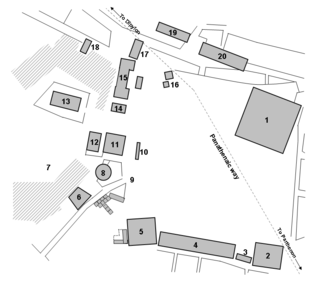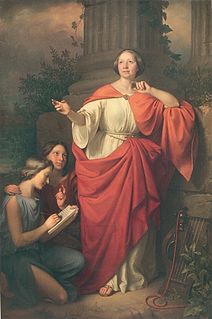Draco, also called Drako or Drakon, was the first recorded legislator of Athens in Ancient Greece. He replaced the prevailing system of oral law and blood feud by the Draconian constitution, a written code to be enforced only by a court of law. Draco was the first democratic legislator requested by the Athenian citizens to be a lawgiver for the city-state, but the citizens had not expected that Draco would establish laws characterized by their harshness.
Fifth-century Athens is the Greek city-state of Athens in the time from 480 to 404 BC. Formerly known as the Golden Age of Athens, the later part being the Age of Pericles, it was buoyed by political hegemony, economic growth and cultural flourishing. The period began in 478 BC, after the defeat of the Persian invasion, when an Athenian-led coalition of city-states, known as the Delian League, confronted the Persians to keep the liberated Asian Greek cities free.

The ancient Agora of Athens is the best-known example of an ancient Greek agora, located to the northwest of the Acropolis and bounded on the south by the hill of the Areopagus and on the west by the hill known as the Agoraios Kolonos, also called Market Hill. The Agora's initial use was for a commercial, assembly, or residential gathering place.

The ecclesia or ekklesia was the assembly of the citizens in city-states of ancient Greece.

The Stoa of Attalos was a stoa in the Agora of Athens, Greece. It was built by and named after King Attalos II of Pergamon, who ruled between 159 BC and 138 BC. The current building was reconstructed from 1952 to 1956 by the American School of Classical Studies at Athens and currently houses the Museum of the Ancient Agora.

The Stoa Poikile or Painted Porch, originally called the Porch of Peisianax, was a stoa erected during the 5th century BC and was located on the north side of the Ancient Agora of Athens. The Stoa Poikile was one of the most famous sites in ancient Athens, owing its fame to the paintings and loot from wars displayed in it.

The Academy was founded by Plato in c. 387 BC in Athens. Aristotle studied there for twenty years before founding his own school, the Lyceum. The Academy persisted throughout the Hellenistic period as a skeptical school, until coming to an end after the death of Philo of Larissa in 83 BC. The Platonic Academy was destroyed by the Roman dictator Sulla in 86 BC.
The law courts in ancient Athens were a fundamental organ of democratic governance. According to Aristotle, whoever controls the courts controls the state.

Stoa Basileios, meaning Royal Stoa, was a stoa constructed in Ancient Athens in the 6th century BC and substantially altered in the 5th century BC. It was located in the northwest corner of the Athenian Agora.

Hermocrates was an ancient Syracusan general during the Athenians' Sicilian Expedition in the midst of the Peloponnesian War. He is also remembered as a character in the Timaeus and Critias dialogues of Plato.
In ancient Greece the chief magistrate in various Greek city states was called eponymous archon. "Archon" means "ruler" or "lord", frequently used as the title of a specific public office, while "eponymous" means that he gave his name to the year in which he held office, much like the Roman dating by consular years.

Diotima of Mantinea is the name or pseudonym of an ancient Greek character in Plato's dialogue Symposium, possibly an actual historical figure, indicated as having lived circa 440 B.C. Her ideas and doctrine of Eros as reported by the character of Socrates in the dialogue are the origin of the concept today known as Platonic love.

The city of Athens during the classical period of ancient Greece was the major urban centre of the notable polis (city-state) of the same name, located in Attica, Greece, leading the Delian League in the Peloponnesian War against Sparta and the Peloponnesian League. Athenian democracy was established in 508 BC under Cleisthenes following the tyranny of Isagoras. This system remained remarkably stable, and with a few brief interruptions remained in place for 180 years, until 322 BC. The peak of Athenian hegemony was achieved in the 440s to 430s BC, known as the Age of Pericles.

The Monument of the Eponymous Heroes, located in the Ancient Agora of Athens, Greece and adjacently situated near the Metroon, was a marble podium that bore the bronze statues of the ten heroes representing the tribes of Athens. Being an important information center for the ancient Athenians, it was used as a monument where proposed legislation, decrees and announcements were posted.

Agoraios Kolonos, located to the south and adjacently situated on a hill near the Temple of Hephaestus, used to be the meeting place of the ancient Athenian craftsmen.

The Altar of the Twelve Gods, was an important altar and sanctuary at Athens, located in the northwest corner of the Classical Agora. The Altar was set up by Pisistratus the Younger, during his archonship, in 522/1 BC. It marked the central point from which distances from Athens were measured and was a place of supplication and refuge.

The Temple of Aphrodite Urania is a temple located north-west of the Ancient Agora of Athens, dedicated to the Greek goddess Aphrodite under her epithet Urania.
The Temple of Apollo Patroos is a small ruined temple of Ionic order built in 340–320 BCE. It is 10 m wide and 16.5 m long, and is located north-west of the Ancient Agora of Athens, near the Stoa of Zeus.

The Church of the Holy Apostles, also known as Holy Apostles of Solaki, is located in the Ancient Agora of Athens, Greece, next to the Stoa of Attalos, and can be dated to around the late 10th century.

The Roman Agora at Athens is located to the north of the Acropolis and to the east of the Ancient Agora.














